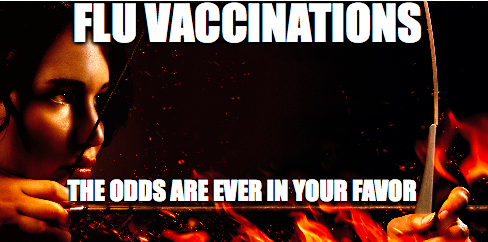 Sorry for the title pun. Second half of the semester, and winter is coming and so is the flu. People debate whether or not the flu vaccination is effective enough to get it. My doctors, parents, and administrators have told me plenty that generally, people should get the vaccine. Some concerns seemed valid though: The flu affects everyone differently, and the vaccine is no panacea. Since my vaccination is tomorrow, I wanted to check it out. Stick with me here.
Sorry for the title pun. Second half of the semester, and winter is coming and so is the flu. People debate whether or not the flu vaccination is effective enough to get it. My doctors, parents, and administrators have told me plenty that generally, people should get the vaccine. Some concerns seemed valid though: The flu affects everyone differently, and the vaccine is no panacea. Since my vaccination is tomorrow, I wanted to check it out. Stick with me here.
First off, here are some things about influenza that we have to get straight. The flu, influenza, is “an infectious respiratory disease caused by type A or type B influenza viruses, which are present in the mucus membranes and secretions of the nose, throat and lungs,” according to the National Vaccine Information Center (NVIC). People can have “flu-like” symptoms that stem from something other than influenza, so it’s common for people to mistake another virus or illness like pneumonia for influenza. The flu vaccine works only on the type A or type B influenza virus strains. Most flu vaccines cover more than one “strain.” Further the NVIC says, usually it’s a three, four, or more part cocktail that covers two type A viruses and a type B virus that the World Health Organization (WHO) and Center for Disease Control (CDC) have predicted will come up during that flu season.
One of the first concerns with flu vaccines is with Thirmerosal, a “mercury-containing organic compound” that acts as a preservative in some vaccines. It’s used for instance in low doses in the flu shot (although not in the nasal spray). Some small studies that showed a link between Thirmerosal and negative health consequences. But here’s the thing. Those studies dealt with unrealistic amounts of Thirmerosal, were extremely small from the 1930s (and are thus outdated when it comes to modern vaccines), and were not replicated. Here’s what the FDA says about it: #1 Any connections to allergic reactions are very rare and very mild. #2 More recent studies have found no significant negative impacts or changes in the body due to Thirmerosal, specifically brain or kidneys (areas where there were some concerns of effects). There is no connection to autism, despite what some politicians have said. For more, I recommend you read the report yourself! So: Thirmerosal is not a reason to avoid vaccines.
Another concern is that the vaccine (just like the flu itself) can affect people differently.  People with certain chronic diseases, says the CDC, “might develop less immunity than healthy children and adults after vaccination. However, even for these people, the flu vaccine still may provide some protection.” Elderly people can sometimes have a lower protective immune response” post-vaccination than younger and healthier people might have. But again, even for them, it is advisable to get the vaccine because the consequences of the flu are typically graver. Elderly people are much more likely to die of the flu or flu-related causes. Some studies the CDC cited showed for people over 50, the effectiveness of the vaccine (in reducing flu-related illnesses and hospitalization) reached near 77%. For generally healthy adults and older kids, the vaccinations tend to reduce flu-related illnesses by about 70%, says the CDC. The result is even higher for other groups. In an experimental study on giving pregnant women the flu vaccine, researchers found with 95% confidence that the vaccine reduced their infants’ risk for hospitalization for the flu by 91.5%. All of these studies have been conducted properly and have been substantiated by other research. So you improve your odds (at nearly any age) of not getting sick and not getting others sick by getting the vaccine.
People with certain chronic diseases, says the CDC, “might develop less immunity than healthy children and adults after vaccination. However, even for these people, the flu vaccine still may provide some protection.” Elderly people can sometimes have a lower protective immune response” post-vaccination than younger and healthier people might have. But again, even for them, it is advisable to get the vaccine because the consequences of the flu are typically graver. Elderly people are much more likely to die of the flu or flu-related causes. Some studies the CDC cited showed for people over 50, the effectiveness of the vaccine (in reducing flu-related illnesses and hospitalization) reached near 77%. For generally healthy adults and older kids, the vaccinations tend to reduce flu-related illnesses by about 70%, says the CDC. The result is even higher for other groups. In an experimental study on giving pregnant women the flu vaccine, researchers found with 95% confidence that the vaccine reduced their infants’ risk for hospitalization for the flu by 91.5%. All of these studies have been conducted properly and have been substantiated by other research. So you improve your odds (at nearly any age) of not getting sick and not getting others sick by getting the vaccine.
Still, it’s easy to focus on the anecdotal and think about the times the vaccine hasn’t worked and has even hurt people. But let’s look at the numbers. In the 2013-2014 flu season, by November 2013 there were about 93,000 “reports of reactions, hospitalizations, injuries and deaths following influenza vaccinations” according to the NVIC. In that same season, by November 2013 there were about 128.6 million doses of flu vaccinations distributed, the CDC reports. I calculated, and that means the chance someone was negatively affected by the virus was 0.0723%, an insignificant figure (promise there’s a blue sliver on that chart). You might worry that these are estimates, not exact numbers. See this link for why and how the CDC estimates Influenza-Associated Deaths in the US. So, don’t worry: the odds are still ever in your favor.
Still not sold on getting the vaccine? How about this: even though a college campus is like a pressure cooker for festering diseases like influenza, college students are usually ridiculously ambivalent about getting vaccinated. In 2012 when swine flu hit the US, “Although college students were among the populations that had the highest frequency of infection for H1N1 influenza, only 8% of them received H1N1 vaccine this past flu season nationwide” University of Buffalo’s Dr. Janet Yang’s research “Too Scared or Too Capable? Why Do College Students Stay Away from the H1N1 Vaccine? reported. Similar trends exist with the regular flu. Fewer people vaccinated means more people infected and more opportunities to come in contact with a person or thing with the virus. Higher risk of infection, higher reward for vaccination. 
Take home message is this: while the flu vaccine is not 100% effective, and its effectiveness varies every year (just like the flu itself), getting the vaccine is advised. It’s advised by the CDC, most scientists and doctors in the field, and by Penn State (check your University Health Services messages). If you’re looking for other ways to make sure you stay healthy this winter at PSU, check out this list. So go to one of these times, or schedule with UHS!

